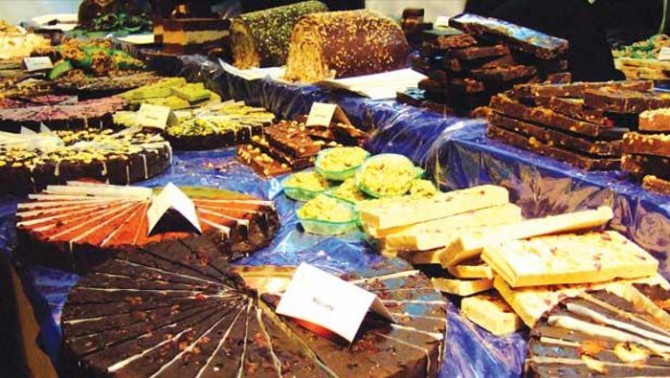Chocolate fit for an Aztec king
( The Times of Malta – 2011 – Caroline Crutchley )
Modica is famed for its annual chocolate festival, when Italian chocolate-makers converge on the town with their products for allto taste.
Modica’s ties with chocolate date back to events which took place in another century, on another continent. In 1590, Montezuma, the King of the Aztecs, welcomed the Spanish Conquistadors to his shores, and Conquistador leader Hernán Cortés was offered a very bitter beverage made with toasted cocoa seeds, maize flour and hot pepper at a ritual ceremony.
The Spanish later killed Montezuma; perhaps they did not like the bitter drink and thought it was poison. However, the cocoa plants and beans went back to Spain. Raw cane sugar was then added to the bitter drink as a sweetener.
From Spain, it travelled across Europe and was easily carried as a quick pick-me-up enjoyed by Spanish warriors while in the saddle. In the 15th century, chocolate arrived into the town of Modica, along with the Spanish army.
The ancient Mayan Indian recipe was guarded secretively in the hands of the nuns, behind the closed doors of convents.
Local confectioners acquired the secret in the 1800s and set about making the distinctly flavoured chocolate, which is true to the original recipe of the Aztec kings.
It is unlike many of the modern variations produced and loved by the Italians, Swiss, British andBelgians. Modican chocolate is granular, it has no cocoa butter or milk added and it does not melt at room temperature. Today it is still made with just pure cacao, cane sugar and flavourings.
I paid a visit to the Modican chocolate factory of Quetzal (www.quetzalmodica.it/en/); the ‘new kids on the chocolate block’, formed in 1995.
Quetzal is a Fair Trade organisation and operates on a not-for-profit basis for the benefit of 14 co-operatives on three continents.
Every ingredient in Quetzal chocolate has been sourced with the producers and farmers in mind. Some of the co-operative members have been lucky enough to make the long journey to Modica to see how their produce is used. There are no middlemen raking-off the profits here.
Cocoa beans come from the Dominican Republic, where 9,200 small farmers pool their opened pods. The beans are dried and roasted before shipment.
The cane sugar comes from Costa Rica, where 12,000 farmers have their own processing plant and, since 1972, 100 farmers have been producing organic cane.
On Panay Island in the Philippines, three farmers use a traditional mill that does not destroy the natural minerals of the sugar. Ecuador sends a small amount too.
Spices are sourced from Sri Lankan farmers who cultivate spices in their ‘spice gardens’ between their rice paddy fields.
Coffee arrives from Mexico, where the indigenous Oaxaca people have been helped to break free from the deadly grip of powerful intermediaries.
The Modican countryside also contributes with carob beans from many of the old trees grown for their crops. The flowering ash tree provides the manna that is extracted from the bark by Giulio and Cecilia Gelardi.
Finally, Michele and Teresa grow organic oranges and lemons for the peel flavourings. These pure ingredients have made their way fromall over the world to produce small blocks of chocolate for me tosample.
Within the tiny factory, beans are crushed and the cocoa mass extracted and then mixed with cane sugar in a large mixing machine. A bain-marie heats the hard mass to just above 40˚C, at which point it melts. The dark, liquid gold is then piped into a mixer where the natural flavourings are added.
Modica is famous for its chilli chocolate – hot and fiery as the Indians liked it. I was lucky enough to be able to test the viscous chocolate dripping from the pipe before it solidified. It is then poured into moulds that are hand-tapped on the steel tabletops to make the trapped air rise to the surface.
Once cooled, the blocks are gently knocked out and wrapped in eco-friendly packaging.
Welcome to Willy Wonka’s ethical chocolate factory, every hippy child’s dream. I am now officially an Umpa Lumpa but without the perma tan and green hair.
Seeing the process was fascinating but now it was time for the hard work. With nearly 15 varieties to sample, I made sure that I left room for all.
My favourites had to be coffee, orange and vanilla. The flavours are not overpowering; they are very subtle and flourish as the chocolate slowly melts.
Try the chilli, carob and pistachio flavours that are the locals’ favourites. The chocolate melted slowly in my mouth, unlike the chocolate I’m used to, because of the lack of milk and cacao fat. I must say I enjoyed the granular sugar effect that remains, as the cooking temperature is too low for the sugar to be broken down.
This was a Mayan experience but Montezuma – famous for his vengeance in Mexico – did not strike me down. I was happy to purchase some bars for later, at a price much cheaper than the shops in town, and I knew I could enjoy this chocolate with a clear conscience.
So if you are a chocoholic visit this factory in Modica, set within a small olive grove, where 13 Modicans res-pect the rights of all those involved in the production line. Quetzal also have a fair trade shop on Corso Umberto, where you can buy knitted and weaved items that have accompanied the raw chocolate materials from around the world.
The Chocobarocco Festival will take place in Modica between October 28 and November 1.
There will be a full programme of tastings that will have chocoholics begging for more. Umpa Lumpas are welcome too.
